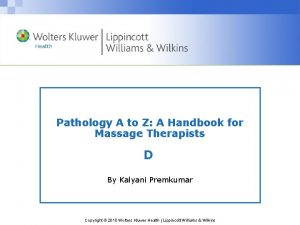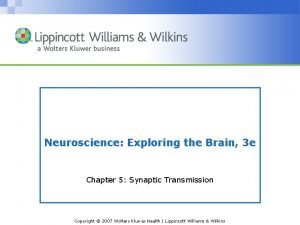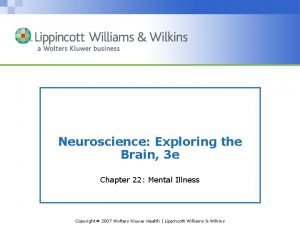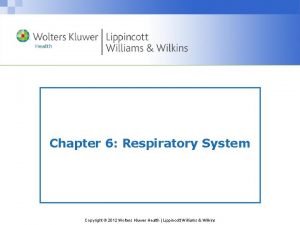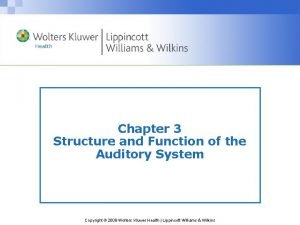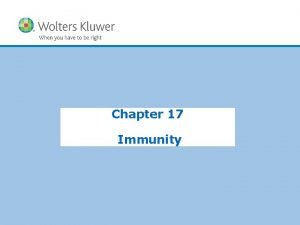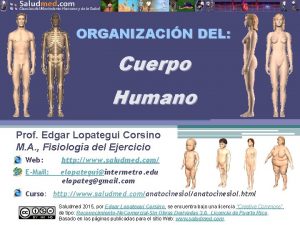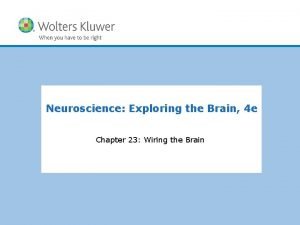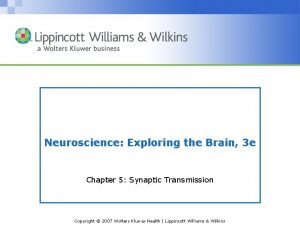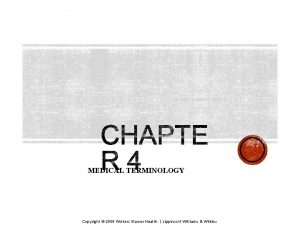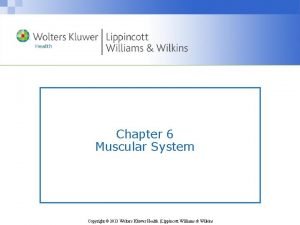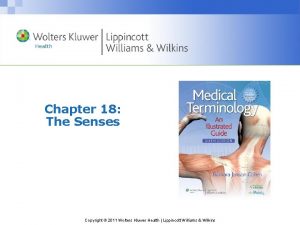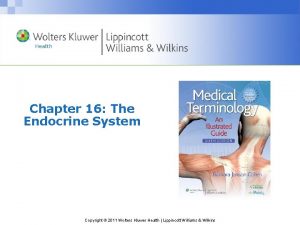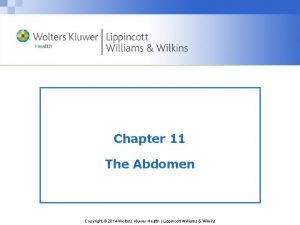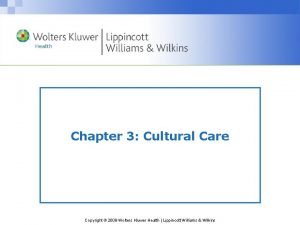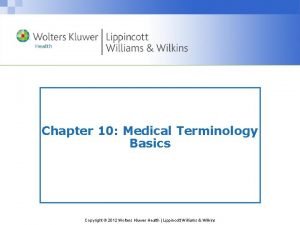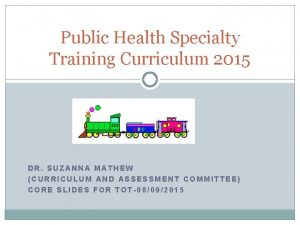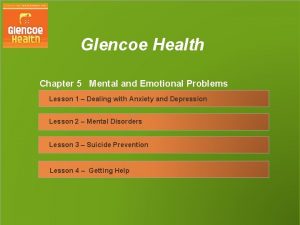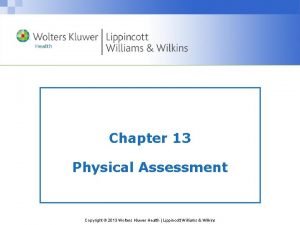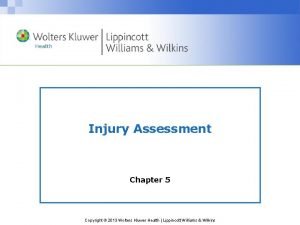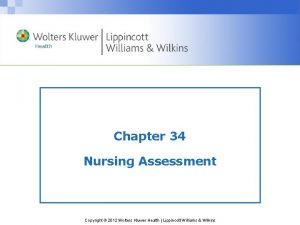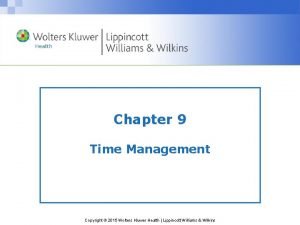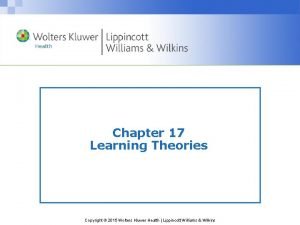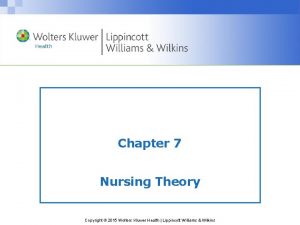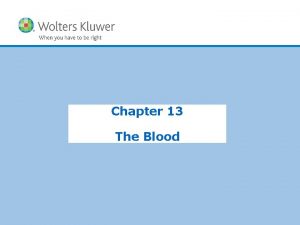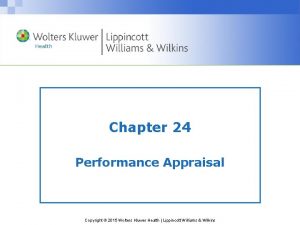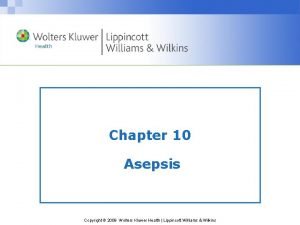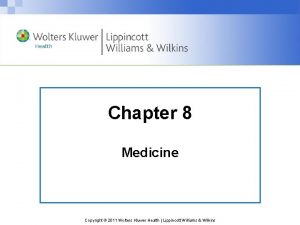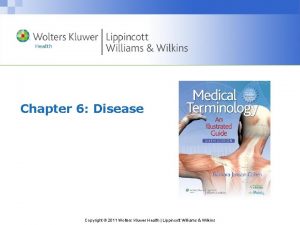Chapter 13Eyes Assessment Copyright 2015 Wolters Kluwer Health












































- Slides: 44

Chapter 13—Eyes Assessment Copyright © 2015 Wolters Kluwer Health | Lippincott Williams & Wilkins

Structure and Function • Eye: sensory organ of sight • Orbital socket: protects complex internal eye structures • Approximate diameter of 1 in. (2. 5 cm) • Extraocular structures: support, protect eyeball – Eyelids – Palpebral fissure – Lid margins; limbus – Conjunctiva; sclera – Lacrimal apparatus Copyright © 2015 Wolters Kluwer • All Rights Reserved

Structure and Function—(cont. ) Copyright © 2015 Wolters Kluwer • All Rights Reserved

Structure and Function—(cont. ) • Extraocular muscle function: six muscles – Superior rectus: elevates upward; adducts, rotates medially – Inferior rectus: rotates downward; adducts, rotates medially – Lateral rectus: moves laterally – Medial rectus: moves medially – Superior oblique: turns downward; abducts, rotates laterally – Inferior oblique: turns upward; abducts, turns laterally Copyright © 2015 Wolters Kluwer • All Rights Reserved

Structure and Function—(cont. ) Copyright © 2015 Wolters Kluwer • All Rights Reserved

Structure and Function—(cont. ) • Intraocular structures – Three layers of tissue • Outer: sclera; cornea • Middle (vascular): iris; ciliary body; choroids • Inner (neural): retina – Three chambers: anterior; posterior; vitreous – Retina: receives/transmits stimuli to brain – Optic disc: opening for optic nerve head – Macula: area of greatest cone concentration Copyright © 2015 Wolters Kluwer • All Rights Reserved

Structure and Function—(cont. ) Copyright © 2015 Wolters Kluwer • All Rights Reserved

Structure and Function—(cont. ) • Vision – Stimuli enters structure via cornea; refracted, inverted, reversed – Focused on retina; communicated via visual pathway to brain – Image returns in original form in brain – Neural pathway (part of CNS) • Optic nerves; optic chasm; optic tracts (continue into optic region of cerebral cortex) Copyright © 2015 Wolters Kluwer • All Rights Reserved

Structure and Function—(cont. ) Copyright © 2015 Wolters Kluwer • All Rights Reserved

Lifespan Considerations: Older Adults • Changes in eye structure and vision – Eyes sit deeper in orbits; eyebrows thin – Conjunctiva thin, may yellow – Iris: irregular pigmentation – Decreased tear formation – Vision may decline – Smaller pupils loss of accommodation; decreased night vision; decreased depth perception – Lens enlarges, transparency decreases Copyright © 2015 Wolters Kluwer • All Rights Reserved

Urgent Assessment • Gradual vision loss: nonemergent • Eye trauma, injuries • Rapid assessment of the eye – Foreign bodies; lacerations; hyphema – Testing ocular movements; examining optic disc • Acute glaucoma (medical emergency) – Blockage of fluid: base between iris, cornea – Can result in permanent vision loss, if untreated Copyright © 2015 Wolters Kluwer • All Rights Reserved

Subjective Data Collection • Assessment of risk factors – Past medical history • Eye: conditions, surgery, health; allergies • Corrective prescriptions; eye protection • Nutritional status – Medications – Family history – Risk factors • Exposure: viruses; environmental Copyright © 2015 Wolters Kluwer • All Rights Reserved

Risk Reduction and Health Promotion • Diabetes mellitus: increase eye problem risk – Diabetic retinopathy; cataracts; glaucoma • Sunlight exposure • Poor diet • Foods: promote eye health – Deep water fish; fruits/vegetables (carrots, spinach) – Hydration • Visual health goals Copyright © 2015 Wolters Kluwer • All Rights Reserved

Common Symptoms • Pain • Trauma or surgery • Visual change • Blind spots, floaters, halos • Discharge • Change in ADLs • Lifespan considerations: older adults • Cultural considerations Copyright © 2015 Wolters Kluwer • All Rights Reserved

Question The neural pathway includes what? A. Optic nerve and peripheral nervous system B. Optic chiasm and optic tracts C. Optic tracts and eyes D. Optic chiasm and cranial nerve VIII Copyright © 2015 Wolters Kluwer • All Rights Reserved

Answer Rationale: The neural pathway consists of the optic nerves, optic chiasm, and optic tracts that continue into the optic region of the cerebral cortex. The neural pathway is part of the central nervous system. Copyright © 2015 Wolters Kluwer • All Rights Reserved

Objective Data Collection • Common and specialty or advanced techniques – Equipment – Preparation • Assessment of visual acuity – Distance vision: Snellen test; Allen test – Near vision: Jaeger chart – Color vision: Ishihara cards Copyright © 2015 Wolters Kluwer • All Rights Reserved

Objective Data Collection—(cont. ) • Assessment of visual fields – Static confrontation – Kinetic confrontation • Assessment of extraocular muscle movements – Corneal light reflex (Hirschberg): strabismus – Cover test: ocular deviation – Cardinal fields of gaze: misalignment, uncoordinated eye movements • Documentation of normal findings Copyright © 2015 Wolters Kluwer • All Rights Reserved

Assessment of External Eyes • External eye structures – Lacrimal apparatus; Bulbar conjunctiva – Sclera; cornea; lens • Assessment of exterior ocular structures – Iris; pupils • Special techniques – Eversion of the eyelid – Fluorescein examination: cornea Copyright © 2015 Wolters Kluwer • All Rights Reserved

Assessment of Internal Ocular Structures • Domain of APRN • Ophthalmoscope: light source; viewing aperture; lens refraction adjustment – Mydriatic drops: short acting ciliary muscle paralytics to dilate pupil • Not used: neurological assessment – Fundus examination – Optic disc inspection – Blood vessels (retina) – Macula examination Copyright © 2015 Wolters Kluwer • All Rights Reserved

Lifespan Considerations: Older Adults • Occur slowly, often overlooked: age related visual changes + consequences – Presbyopia: normal aging • Leading causes of blindness in United States – Cataracts; age related macular degeneration (AMD) • Central vision acuity loss • Diabetic retinopathy • Testing older adults with dementia: Strategies • Cultural considerations Copyright © 2015 Wolters Kluwer • All Rights Reserved

Critical Thinking • Diagnostic reasoning: Nursing Diagnoses, Outcomes, Interventions – Outcomes (partial list) • Patient will remain safe in home environment. • Patient will state measures to reduce risk of visual loss. – Nursing interventions (partial list) • Keep furniture out of pathways and keep cords against walls. • Ensure access to eyeglasses or magnifiers as needed. Copyright © 2015 Wolters Kluwer • All Rights Reserved

Question When inspecting the bulbar conjunctiva, what would you expect to find? a. A pink to light red color b. Small areas of rough tissue c. Small blood vessels d. An opaque membrane Copyright © 2015 Wolters Kluwer • All Rights Reserved

Answer Bulbar conjunctiva is normally transparent with small blood vessels visible. Copyright © 2015 Wolters Kluwer • All Rights Reserved

NCLEX-Style Review Questions Which of the following patients would require immediate nursing care? a. An 8 year old girl with pink conjunctivae and drainage b. A 20 year old man with sudden visual loss after playing football c. A 52 year old woman with clouding of vision d. A 77 year old man with loss of vision in his peripheral fields Copyright © 2015 Wolters Kluwer • All Rights Reserved

NCLEX-Style Review Questions Rationale: Sudden loss of vision is an emergency, especially following a potentially traumatic injury; this patient is at risk for retinal detachment. The 8 year old girl may have conjunctivitis. The 52 year old woman has symptoms of cataract, and the 77 year old man has symptoms of macular degeneration. Copyright © 2015 Wolters Kluwer • All Rights Reserved

NCLEX-Style Review Questions Which of the following teaching points would the nurse emphasize related to eye health? a. Always wear eye protection for occupational exposures. b. Eat a diet high in animal protein and dairy. c. Exercise five times a week for at least 20 minutes. d. Get at least 7 hours of sleep each night. Copyright © 2015 Wolters Kluwer • All Rights Reserved

NCLEX-Style Review Questions Rationale: Two health goals are to (1) increase the proportion of public and private schools that require use of appropriate head, face, eye, and mouth protection for students participating in school sponsored physical activities and (2) reduce occupational eye injury and increase the use of appropriate personal protective eyewear in recreational activities and hazardous situations around the home. Copyright © 2015 Wolters Kluwer • All Rights Reserved

NCLEX-Style Review Questions Which of the following symptoms would the nurse expect the patient to report as translucent specks that drift across the visual field? a. Blind spot b. Ptosis c. Halo d. Floater Copyright © 2015 Wolters Kluwer • All Rights Reserved

NCLEX-Style Review Questions Rationale: A blind spot may be related to a problem of the optic nerve (CN II). Ptosis is usually related to stroke or paralysis in the eye area. A halo is seen in patients with glaucoma, lens opacities, and some drug toxicities. Copyright © 2015 Wolters Kluwer • All Rights Reserved

NCLEX-Style Review Questions When working with an older adult, what would the nurse emphasize as increased risks for the patient? a. Myopia and strabismus b. Blepharitis and chalazion c. Glaucoma and cataracts d. Exophthalmos and presbyopia Copyright © 2015 Wolters Kluwer • All Rights Reserved

NCLEX-Style Review Questions Rationale: Glaucoma, cataracts, and macular degeneration are all more common in the elderly. Myopia is nearsightedness; with strabismus, a person cannot align both eyes simultaneously under normal conditions (cross eyes). Blepharitis is inflammation of the margin of the eyelid; chalazion is a cyst in the eyelid. Exophthalmos is anterior protrusion of the eyeball out of the socket; presbyopia is believed to be caused by the loss of elasticity of the crystalline lens. Copyright © 2015 Wolters Kluwer • All Rights Reserved

NCLEX-Style Review Questions A public health nurse is performing annual vision screening for residents in senior housing. Which of the following charts would the nurse most likely be using? a. Allen chart b. Snellen chart c. Ishihara cards d. Confrontation cards Copyright © 2015 Wolters Kluwer • All Rights Reserved

NCLEX-Style Review Questions Rationale: The Allen chart is used to test near vision. Ishihara cards are used to test color blindness. Confrontation is a test for peripheral vision. Copyright © 2015 Wolters Kluwer • All Rights Reserved

NCLEX-Style Review Questions Which of the following scores for distance vision indicates the patient with the poorest vision? a. 200/20 b. 18/20 c. 24/20 d. 20/100 Copyright © 2015 Wolters Kluwer • All Rights Reserved

NCLEX-Style Review Questions Rationale: Normal refractive index is 20/20. Visual acuity for distance vision is documented in reference to what a person with normal vision can see standing 6 meters (20 feet) in front of the test (which is the numerator). The numerator is compared to what a person with normal visual acuity could read on that particular line (which is the denominator). Someone with 20/20 vision can read at 20 feet what a person with normal vision can read at 20 feet. Copyright © 2015 Wolters Kluwer • All Rights Reserved

NCLEX-Style Review Questions The nurse recognizes that the 60 year old patient may have difficulty reading fine print because of a. the loss of accommodation. b. anisocoria. c. amblyopia. d. asthenopia. Copyright © 2015 Wolters Kluwer • All Rights Reserved

NCLEX-Style Review Questions Rationale: Loss of the ability to accommodate (contract the pupil for near vision) begins at around age 40 years, when many patients start using reading glasses. Unequal pupils usually are from a defect in efferent nervous pathways controlling the oculomotor nerve. Amblyopia (lazy eye) is used to describe a condition in which vision in one eye is reduced because the eye and brain do not work together correctly. Asthenopia (eye strain) develops after reading, computer work, or other visually tedious tasks. Copyright © 2015 Wolters Kluwer • All Rights Reserved

NCLEX-Style Review Questions Peripheral vision is evaluated by the nurse using the a. corneal light test. b. cover test. c. confrontation test. d. cardinal fields of gaze test. Copyright © 2015 Wolters Kluwer • All Rights Reserved

NCLEX-Style Review Questions Rationale: The corneal light reflex is a test for strabismus. The cover test is to assess the presence and amount of ocular deviation. The cardinal fields of gaze test is used to evaluate motor function in the eyes. Copyright © 2015 Wolters Kluwer • All Rights Reserved

NCLEX-Style Review Questions The cranial nerves involved with eye movement include a. II, V, and VII. b. III, IV, and VI. c. IV, V, and VIII. d. V, VI, and VII. Copyright © 2015 Wolters Kluwer • All Rights Reserved

NCLEX-Style Review Questions Rationale: The cranial nerves for the eye include II, IV, and VI. The optic nerve is in the central nervous system, whereas cranial nerves III, IV, and VI control the muscles of the eye. Copyright © 2015 Wolters Kluwer • All Rights Reserved

NCLEX-Style Review Questions The nurse assesses the response of the eye to light and documents normal findings as a. PEERLA. b. PERRLA. c. PERLLA. d. PERLAA. Copyright © 2015 Wolters Kluwer • All Rights Reserved

NCLEX-Style Review Questions Rationale: The pupils are equal, round, and reactive to light and accommodation. This is abbreviated as PERRLA. Copyright © 2015 Wolters Kluwer • All Rights Reserved
 Wolters kluwer health
Wolters kluwer health Lippincott
Lippincott Chemical synapse
Chemical synapse Wolters kluwer health
Wolters kluwer health Wolters kluwer health
Wolters kluwer health Wolters kluwer health
Wolters kluwer health Wolters kluwer health
Wolters kluwer health Wolters kluwer
Wolters kluwer Wolters kluwer health lippincott williams & wilkins
Wolters kluwer health lippincott williams & wilkins Wolters kluwer
Wolters kluwer Wolters kluwer
Wolters kluwer Shunting inhibition
Shunting inhibition Wolters kluwer
Wolters kluwer Wolters kluwer
Wolters kluwer Chapter 25 assessment of cardiovascular function
Chapter 25 assessment of cardiovascular function Wolters kluwer
Wolters kluwer Wolters kluwer pronunciation
Wolters kluwer pronunciation Wolters kluwer
Wolters kluwer Wolters kluwer
Wolters kluwer Wolters kluwer
Wolters kluwer Wolters kluwer
Wolters kluwer Wolters kluwer
Wolters kluwer Wolters kluwer ovid
Wolters kluwer ovid Wolters kluwer culture
Wolters kluwer culture Wolters kluwer pronunciation
Wolters kluwer pronunciation Copyright 2015 all rights reserved
Copyright 2015 all rights reserved Copyright 2015 all rights reserved
Copyright 2015 all rights reserved Kluwer
Kluwer Kluwer congres
Kluwer congres Iso 9001:2015 risk assessment example
Iso 9001:2015 risk assessment example Fph curriculum 2015
Fph curriculum 2015 Iuss health facility guidelines
Iuss health facility guidelines Chapter 5 mental and emotional problems
Chapter 5 mental and emotional problems Chapter 3 health wellness and health disparities
Chapter 3 health wellness and health disparities Chapter 1 lesson 2 what affects your health
Chapter 1 lesson 2 what affects your health Chapter 1 lesson 1 your total health
Chapter 1 lesson 1 your total health Chapter 10 chemical reactions
Chapter 10 chemical reactions Chapter 11 stoichiometry test answer key
Chapter 11 stoichiometry test answer key Chapter 9 chapter assessment chemical reactions
Chapter 9 chapter assessment chemical reactions Chapter 9 surface water chapter assessment answer key
Chapter 9 surface water chapter assessment answer key Chapter 2 representing motion chapter assessment
Chapter 2 representing motion chapter assessment Chapter 1 chapter assessment the central science
Chapter 1 chapter assessment the central science Chapter 2 standardized test practice answers
Chapter 2 standardized test practice answers Properties of ionic compounds
Properties of ionic compounds Chemistry chapter 7 ionic and metallic bonding
Chemistry chapter 7 ionic and metallic bonding

